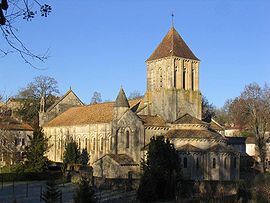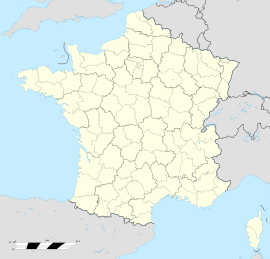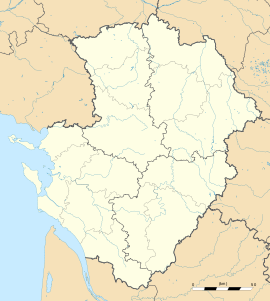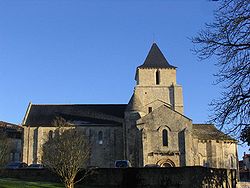- Melle, Deux-Sèvres
-
Melle
Saint-Hilaire Church Administration Country France Region Poitou-Charentes Department Deux-Sèvres Arrondissement Niort Canton Melle Intercommunality Canton of Melle Mayor Yves Debien
(2008–2014)Statistics Elevation 87–174 m (285–571 ft)
(avg. 119 m/390 ft)Land area1 9.76 km2 (3.77 sq mi) Population2 3,908 (2006) - Density 400 /km2 (1,000 /sq mi) INSEE/Postal code 79174/ 79500 1 French Land Register data, which excludes lakes, ponds, glaciers > 1 km² (0.386 sq mi or 247 acres) and river estuaries. 2 Population without double counting: residents of multiple communes (e.g., students and military personnel) only counted once. Coordinates: 46°13′22″N 0°08′38″W / 46.2227777778°N 0.143888888889°W
Melle is a commune in the Deux-Sèvres department in western France.
It is today best known as the home town of Ségolène Royal, the 2007 Socialist candidate for the election of the Presidency of the Republic. Laurent Cantet was also born here.
Contents
History
The town was founded in the reign of Charlemagne as a mining centre and was, for a time, the home of the French mint. The mines which supplied the mint continued to function off and on before being forgotten altogether in the 18th century, not to be discovered again until the 20th century. The mine is now a tourist attraction and can be visited most days of the year.
In the Middle Ages, Melle flourished as a town as we can see from its surviving medieval houses and the three churches, built in the Romanesque style during the 11th and 12th centuries.
Sights
Melle is an ancient town which has traditional French architecture, some dating back before the 17th century.
Melle is the site of the oldest silver mine in Europe still open to the public. The mine itself is some 20 km (12 mi) long, and visitors can explore 350 m of it, with guided tours each day.
The church of Saint-Hilaire is the most beautiful of the three Melle churches, all of which merit a visit. Saint-Hilaire has an "ecclesiastical juke-box" which plays hymns and chants. The church of Saint-Hilaire was listed as a UNESCO World Heritage Site as part of the World Heritage Sites of the Routes of Santiago de Compostela in France.
Among other places to visit are the wash-houses and fountains of Melle. 400m from the church of Saint-Pierre is a small octagonal building with an arcade around. There you will find a fountain pouring from the rock, and the basin where women doing their washing gathered. In the meadow nearby is a medieval fountain and basin, known as the Pré de la Maladerie, which was reserved for lepers.
Melle also boasts a 6 km (3.7 mi) walk known as the 'Arboretum, Chemin de la Découverte'. This walk passes more than 1000 species of trees and shrubs from the temperate areas of the world, and a collection of over 100 roses.
Melle today
Today, Melle is a vibrant small town. It is the major hub of business for the nearby towns of Saint-Léger, Chef-Boutonne, and Celles-sur-Belle and this is demonstrated by its large business community and by the fact that it is home to the lycée (high school) for the region. Melle and the surrounding countryside is known for its own particular type of goat's cheese, 'chabichou'.
The rural atmosphere of Melle can be experienced nowhere better than at the weekly market (every Friday), selling fresh vegetables, meat, bread, cheeses and many other French delicacies, as well as clothing and household goods. The area surrounding Melle is full of Romanesque châteaux, mills, fountains and wash houses. There are forests of chestnut, walnut and parasol pines.
The town boasts a variety of traditional shops, as well as two large supermarkets and several restaurants featuring regional French cuisine, a popular steak house, and a pizza parlour.
Around Melle
One of the finest zoos in France is not far away. Zoorama in the Forest of Chizé, commune of Villiers-en-Bois, contains 600 animals in large enclosures, which can be observed from Hides and ditches.
Lambon, 10 km (6.2 mi) from Melle is a wonderful leisure centre for families. Rowing, sailing, swimming and fishing are all catered for, as is horse-riding over the 50 hectares of the site. There are also tennis courts and a children's playground.
See also
References
Categories:- Communes of Deux-Sèvres
- World Heritage Sites in France
Wikimedia Foundation. 2010.





